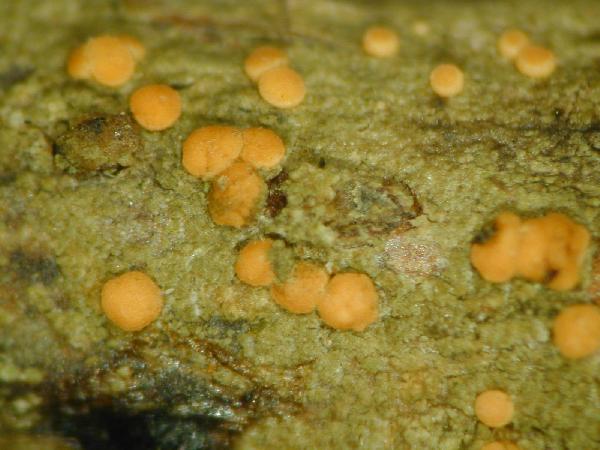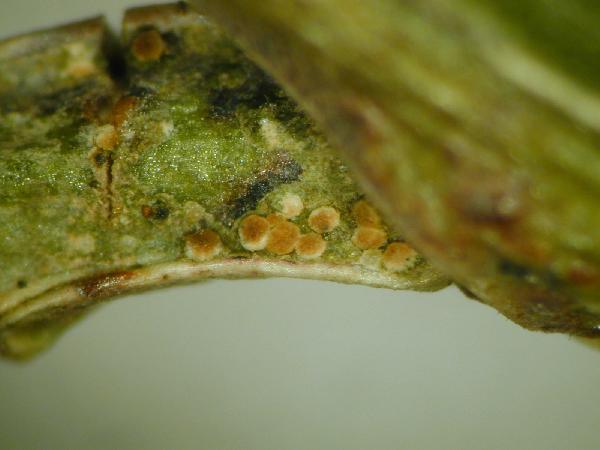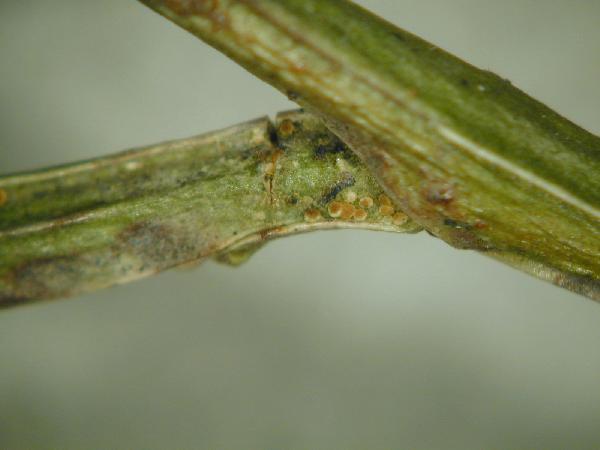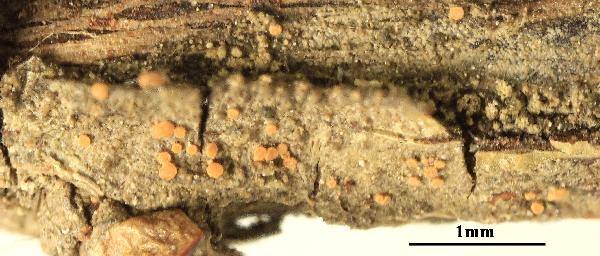Fellhanera subtilis (Vězda) Diederich & Sérus.
in Sérusiaux, Mém. Soc. roy. Bot. Belg., 12: 142, 1990. Basionym: Bacidia subtilis Vězda - Preslia, 33: 367, 1961.
Synonyms: Arthonia subtilis (Vězda) Vězda
Distribution: N - Frl, Ven (Nascimbene & al. 2021). S - Bas (Herb. von Brackel 2799).
Description: Thallus crustose, episubstratic, 0.1-0.5 mm thick, grey-green, often shiny, smooth to granulose, esorediate. Apothecia biatorine, clustered towards thallus center, 0.1-0.5 mm across, with a flat to finally convex, whitish, pale grey-pink to pale brown disc, and a thin, paler, finally excluded proper margin. Proper exciple well-developed, thin, more or less colourless; epithecium, hymenium and hypothecium colourless; hymenium 40-60 µm high, I+ blue; paraphyses simple or sparingly branched, 0.5-1 µm thick at base, the apical cells to 2 µm wide. Asci 8-spored, clavate, with a K/I+ blue apical dome containing a darker blue, tubular ring-structure, and an amyloid coat, Byssoloma-type. Ascospores (1-)3-septate, narrowly fusiform to clavate-fusiform, sometimes slightly curved, 10-16 x (2.5-)3.5-4.5(-5) µm. Pycnidia pinkish white, 0.1-0.3 mm across, immersed to emergent and thorn-like with a long neck. Conidia pear- or drop-shaped to almost ellipsoid, 3.5-4.6 x c. 1.5 µm. Photobiont chlorococcoid. Spot tests: thallus K-, C-, KC-, P-, UV-. Chemistry: without lichen substances. Note: on twigs of small shrubs (e.g. Vaccinium, Calluna), more rarely on mosses (e.g. Polytrichum) and on twigs of Picea in cold sites, on north-facing slopes or in deep gorges, usually in upland areas; perhaps more widespread in the Alps. It is included in the Italian red list of epiphytic lichens as “Endangered” (Nascimbene & al. 2013c).
Growth form: Crustose
Substrata: bark
Photobiont: green algae other than Trentepohlia
Reproductive strategy: mainly sexual
Most common in areas with a humid-warm climate (e.g. most of Tyrrenian Italy)
Commonnes-rarity: (info)
Alpine belt: absent
Subalpine belt: very rare
Oromediterranean belt: absent
Montane belt: extremely rare
Submediterranean belt: absent
Padanian area: absent
Humid submediterranean belt: absent
Humid mediterranean belt: absent
Dry mediterranean belt: absent

Predictive model
Herbarium samples

Jacques Haine - Source: http://www.lichensmaritimes.org/index.php?task=fiche&lichen=769&lang=en
France, Ardennes

Jacques Haine - Source: http://www.lichensmaritimes.org/index.php?task=fiche&lichen=769&lang=en
France, Ardennes

Jacques Haine - Source: http://www.lichensmaritimes.org/index.php?task=fiche&lichen=769&lang=en
France, Ardennes

Jacques Haine - Source: http://www.lichensmaritimes.org/index.php?task=fiche&lichen=769&lang=en
France, Ardennes

Jacques Haine - Source: http://www.lichensmaritimes.org/index.php?task=fiche&lichen=769&lang=en
France, Ardennes

Jacques Haine - Source: http://www.lichensmaritimes.org/index.php?task=fiche&lichen=769&lang=en
France, Ardennes

Jacques Haine - Source: http://www.lichensmaritimes.org/index.php?task=fiche&lichen=769&lang=en
France, Ardennes

Jacques Haine - Source: http://www.lichensmaritimes.org/index.php?task=fiche&lichen=769&lang=en
France, Ardennes
Growth form: Crustose
Substrata: bark
Photobiont: green algae other than Trentepohlia
Reproductive strategy: mainly sexual
Most common in areas with a humid-warm climate (e.g. most of Tyrrenian Italy)
Commonnes-rarity: (info)
Alpine belt: absent
Subalpine belt: very rare
Oromediterranean belt: absent
Montane belt: extremely rare
Submediterranean belt: absent
Padanian area: absent
Humid submediterranean belt: absent
Humid mediterranean belt: absent
Dry mediterranean belt: absent

Predictive model
| Herbarium samples |

Jacques Haine - Source: http://www.lichensmaritimes.org/index.php?task=fiche&lichen=769&lang=en
France, Ardennes

Jacques Haine - Source: http://www.lichensmaritimes.org/index.php?task=fiche&lichen=769&lang=en
France, Ardennes

Jacques Haine - Source: http://www.lichensmaritimes.org/index.php?task=fiche&lichen=769&lang=en
France, Ardennes

Jacques Haine - Source: http://www.lichensmaritimes.org/index.php?task=fiche&lichen=769&lang=en
France, Ardennes

Jacques Haine - Source: http://www.lichensmaritimes.org/index.php?task=fiche&lichen=769&lang=en
France, Ardennes

Jacques Haine - Source: http://www.lichensmaritimes.org/index.php?task=fiche&lichen=769&lang=en
France, Ardennes

Jacques Haine - Source: http://www.lichensmaritimes.org/index.php?task=fiche&lichen=769&lang=en
France, Ardennes

 INDEX FUNGORUM
INDEX FUNGORUM
 GBIF
GBIF
 DOLICHENS
DOLICHENS











